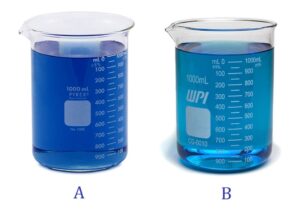How does temperature and pressure affect dissolved oxygen readings?
Everyone knows that H2O is the chemical equation for water, but what is H2O4?
H2O is for (4) drinking, taking a bath, swimming…

Take a look at these two beakers. Notice that B appears to be over the 1000mL (1 Liter) mark. What if I told you that both of these beakers contained the same mass? What if I told you that both liquids were identical in every way including the same number of water molecules? The only difference between these liquids are where they are located. How could that be?
You may know that materials expand and contract with temperature. If a material such as the water in Beaker A is placed in a warmer environment it will increase in volume, like Beaker B. The warmer something is, the bigger it will be. The cooler something is, the smaller it will be. The energy (heat) that is put into the liquid makes the molecules more active. This extra activity demands room, much like a room full of people trying to do jumping jacks.
Pressure has a similar but opposite effect. The higher the pressure the smaller something will be. It is much like trying to fit more stuff in a suitcase; the more stuff you jam in the same volume the higher the pressure trying to rip the suitcase open. If you take Beaker A to the top of a high mountain, the air pressure (barometric pressure) will be less. Less pressure forcing the liquid into the beaker allows the liquid to expand like in Beaker B.
If Beaker A contained 5mg of salt, we would say that the liquid contained 5mg/L (milligrams per Liter) of salt. However, if we heat the liquid to bring its total volume to 1050mL, we would say that the liquid contained 5mg/1050mL of salt. We can assume that the salt is distributed evenly throughout the solution and that the extra 50mL of liquid in Beaker B would contain some of the original 5mg of salt. Therefore, we would know that the solution when heated will contain less than 5mg/L of salt. The salt becomes less concentrated as the liquid expands.
DO (dissolved oxygen) is measured in mg/L. The mass (weight) of each extra O2 (oxygen) molecule in a liter of water can be added together to get the resulting measurement of DO. When a liter of water (A) is heated, you will soon have more than a liter of water do to normal expansion (B). If that extra water is contains some of the O2, then the mass of the remaining O2 molecules are added together the result will be less than moments ago. We can say that the DO reading decreased; there is less mg of O2 per Liter of water.
A similar result can be obtained with changes of barometric pressure. If a liter of water at sea level (higher barometric pressure) is brought to the top of a mountain (lower BP) you would have a greater volume of water than your original liter. This is because the water would expand as the pressure forcing it together lessens. The result of your DO reading would go down; just like you heated the water as before.
In summary, the amount of oxygen in the water does not normally change with changes in temperature or pressure. What changes is the water’s overall density which results in a change in oxygen in a specific volume of water.

